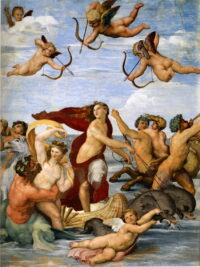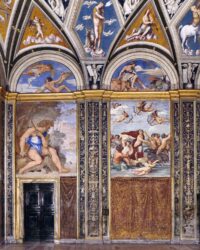Egyptian blue, the world’s first known synthetic pigment, was used for thousands of years starting around 2600 B.C. The Romans called it caeruleum (the source of the English word cerulean). Vitruvius included a recipe for it in De architectura, Book VII, Chapter 11:
Sand is ground with flowers of sulphur, till the mixture is as fine as flour, to which coarse filings of Cyprian copper are added, so as to make a paste when moistened with water; this is rolled into balls with the hand, and dried. The balls are then put into an earthen vessel, and that is placed in a furnace. Thus the copper and sand heating together by the intensity of the fire, impart to each other their different qualities, and thereby acquire their blue colour.
The knowledge of how to make Egyptian blue was lost with the Fall of the Roman Empire. Vitruvius’ works were rediscovered in a Swiss monastery library in 1414 and first published in Latin in 1486. The lost recipe of Egyptian Blue, however, would not be rediscovered until the early 19th century when chemist Humphry Davy found lumps of it in the ruins of the Baths of Titus in Rome and discovered its chemical formula (calcium copper silicate). Or so we thought.
 A new study of Raphael’s fresco The Triumph of Galatea, in Rome’s Villa Farnesina, has found that the Renaissance master recreated Egyptian blue for this work, and as far as we know, this work alone. Using non-invasive macro-X-ray fluorescence (MAXRF), researchers discovered to their surprise that the blue of the sea and sky were calcium copper silicate.
A new study of Raphael’s fresco The Triumph of Galatea, in Rome’s Villa Farnesina, has found that the Renaissance master recreated Egyptian blue for this work, and as far as we know, this work alone. Using non-invasive macro-X-ray fluorescence (MAXRF), researchers discovered to their surprise that the blue of the sea and sky were calcium copper silicate.
The Villa Farnesina was built for banker Agostino Chigi, treasurer to Pope Julius II and the richest man in Rome, by architect Baldassare Peruzzi. Construction was completed in 1512 but the frescoing of its interior began as soon as the walls were done in 1511. Chigi commissioned the greatest artists of his time for the job. Besides Raphael, Sebastiano del Piombo, Giovanni da Udine, Giulio Romano and Giovanni Bazzi, aka Il Sodoma.
Raphael painted The Triumph of Galatea on the wall of the loggia, a grand space that was originally the main entrance hall of the villa. It depicts the Nereid Galatea standing on a seashell drawn by two dolphin steeds while winged Cupids aim their arrows at her. A neighboring panel by del Piombo depicts the Cyclops Polyphemus who kills Galatea’s beloved, the shepherd Acis, in a jealous rage.
 Galatea was completed around 1514, seven years before the first Italian edition of Vitruvius’ De architectura was published. In a letter purportedly written by Raphael to his friend Baldassare Castiglione, the artist thanked the courtier for his compliments on Galatea and linked his painted to the forms of antiquity illuminated by Vitruvius. The letter is a copy and of uncertain authenticity, but it is certain that Raphael and other Renaissance artists had read Vitruvius and been hugely influenced by him.
Galatea was completed around 1514, seven years before the first Italian edition of Vitruvius’ De architectura was published. In a letter purportedly written by Raphael to his friend Baldassare Castiglione, the artist thanked the courtier for his compliments on Galatea and linked his painted to the forms of antiquity illuminated by Vitruvius. The letter is a copy and of uncertain authenticity, but it is certain that Raphael and other Renaissance artists had read Vitruvius and been hugely influenced by him.
None of the other Raphael frescoes of Villa Farnesina use Egyptian Blue. His Cupid and Psyche fresco cycle on the ceiling of the loggia has a vast blue background, all made out of lapis lazuli pigment. That fresco has been digitized and can be explored here, btw. There are annotations explaining the incredible proliferation of botanical motifs surrounding the scenes from Greek mythology